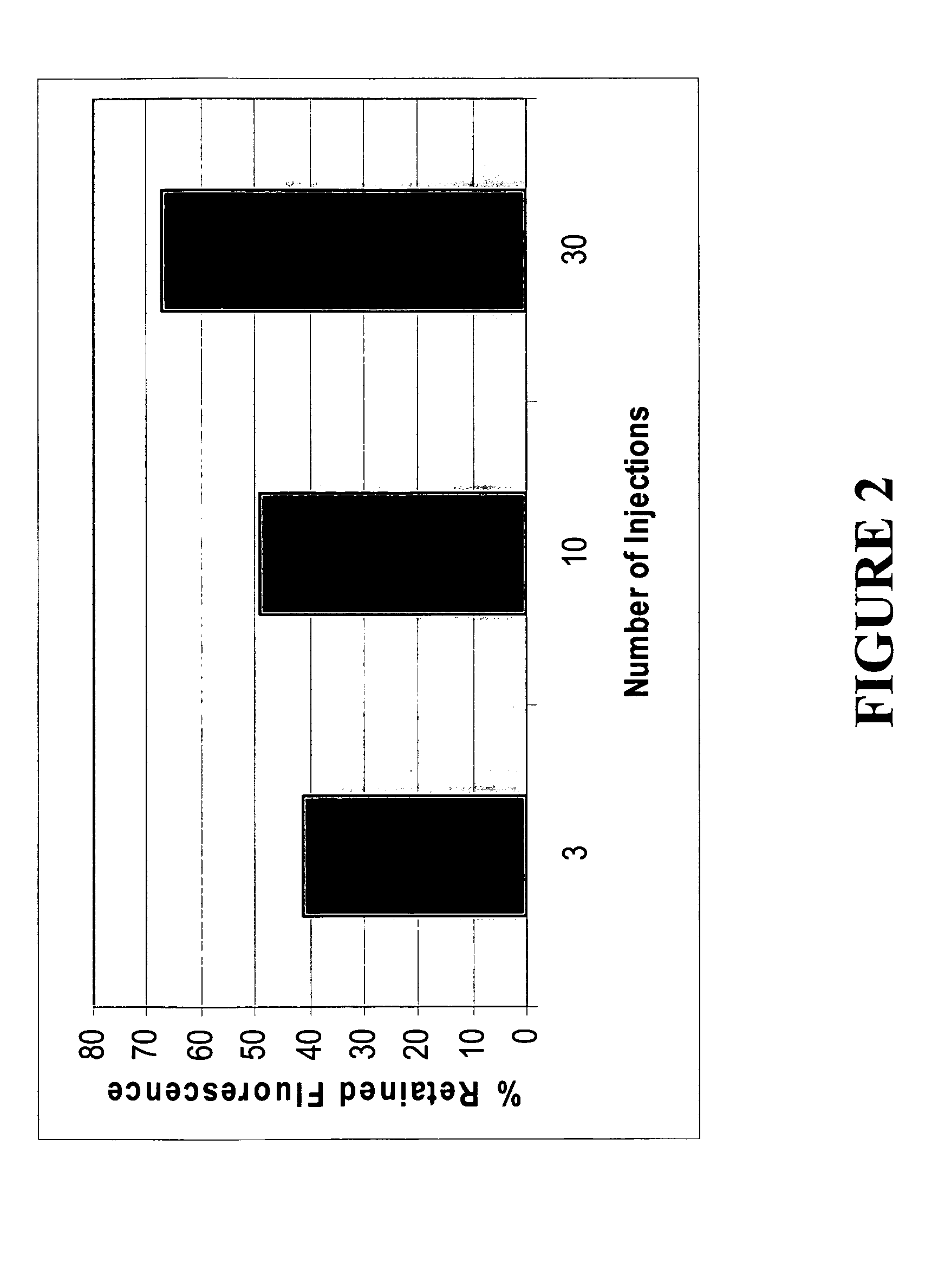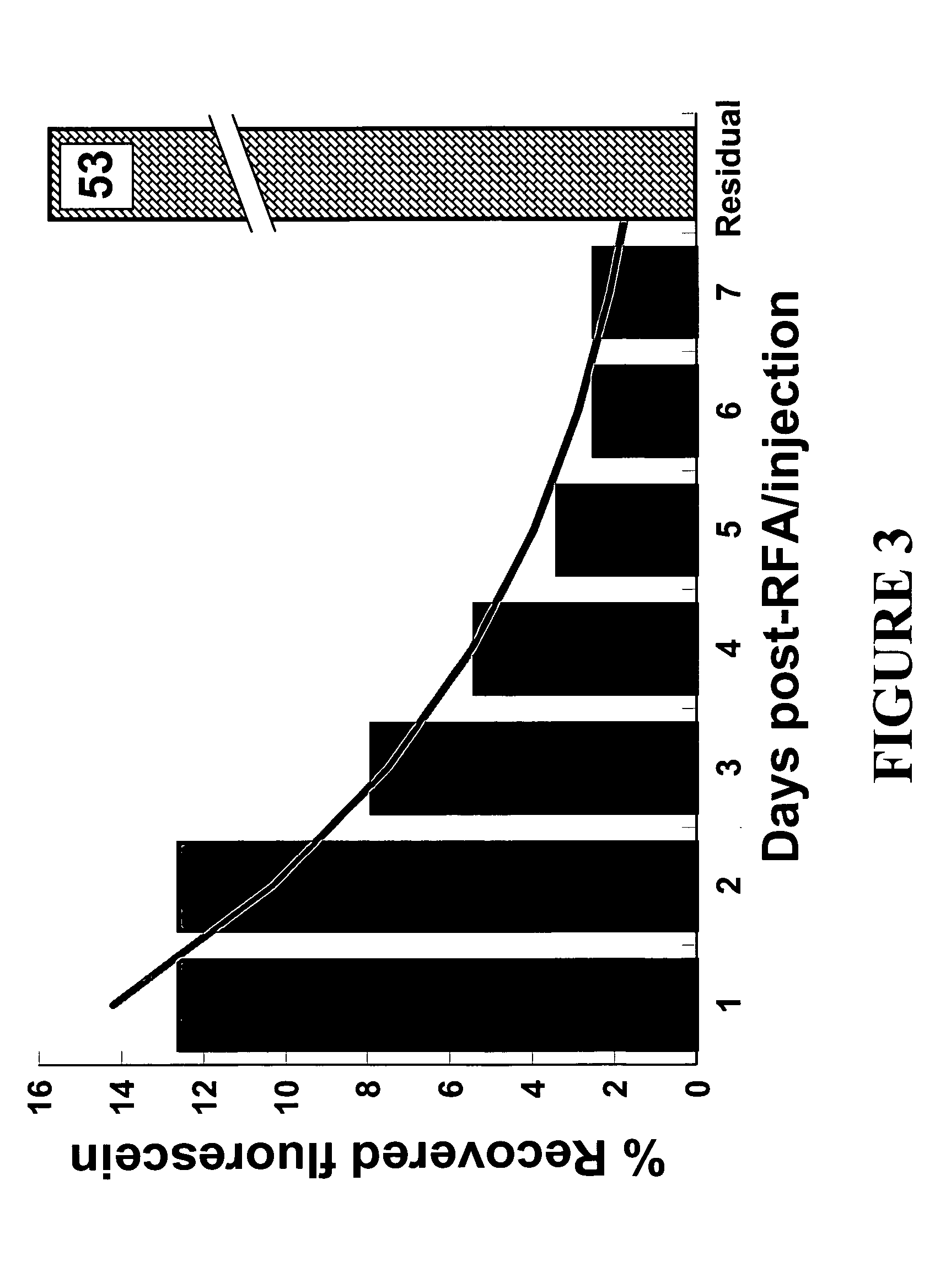Method for the delivery of sustained release agents
a technology of agents and agents, applied in the direction of drug compositions, peptide/protein ingredients, genetic material ingredients, etc., can solve the problems of poor economic burden for patients and the community, diverse mechanisms of cancer development and propagation, and the curative results of this approach, for the most part, to be disappointing
- Summary
- Abstract
- Description
- Claims
- Application Information
AI Technical Summary
Benefits of technology
Problems solved by technology
Method used
Image
Examples
example 1
Fluorescein Retention in RF Ablated Tissue
[0027] Bovine liver was ablated, injected multiple times with fluorescein. To demonstrate the effectiveness of the injections, the tissue was bivalved and agitated in 1 L of phosphate buffered saline (PBS) for extended periods of time. The PBS was exchanged daily for two weeks. At weekly intervals, the ablated tissue was photographed under ultraviolet (UV) light. According to FIG. 1, fluorescein was easily detected within the ablated tissue for at least two weeks, at which point, fluorescein was still being eluted from the ablated tissue (Panel C of FIG. 1). This approach can be used to help train and assess people to use the technique.
example 2
Multiple Injections Improved Fluorescein Retention by RF Ablated Tissue
[0028] Ablated bovine liver, prepared as in Example 1, was injected 3, 10, or 30 times with fluorescein (total volume of 0.5 mL). The tissue was extensively washed over 10 minutes; and the retained fluorescein was calculated as a percentage of the total injected fluorescein. To quantify the retained fluorescein, the washed tissue was homogenized, centrifuged and the supernatant assessed for fluorescein using a fluorimeter with excitation and emission filters of 485 nm and 525 nm, respectively.
[0029] According to FIG. 2, up to about 65% of the injected fluorescein was retained by the RF ablated liver when 30 injections were used, while the 10 and 3 injections retained 49% and 41% of the fluorescein, respectively. This clearly indicated that the amount of fluorescein retention correlated positively with the number of injections when using a single needle device. Multi-needle devices could be developed to accompli...
example 3
Exponential Release of Fluorescein from RF Ablated Tissue
[0030] To determine the rate of fluorescein release, bovine liver was ablated with RF and injected with fluorescein. According to FIG. 3, which depicted the amount of fluorescein released by the ablated tissue as well as the retained fluorescein as a percentage of the total recovered fluorescence, the released fluorescein followed an exponential decline. However, after one week of continued washing, the ablated tissue still contained greater than 50% of the original fluorescein. These data demonstrated in an ex vivo model that RF ablated tissue provides a mechanism to deliver high local concentrations of molecules that can be slowly released over prolonged periods of time.
PUM
| Property | Measurement | Unit |
|---|---|---|
| Chemotherapeutic properties | aaaaa | aaaaa |
Abstract
Description
Claims
Application Information
 Login to View More
Login to View More - R&D
- Intellectual Property
- Life Sciences
- Materials
- Tech Scout
- Unparalleled Data Quality
- Higher Quality Content
- 60% Fewer Hallucinations
Browse by: Latest US Patents, China's latest patents, Technical Efficacy Thesaurus, Application Domain, Technology Topic, Popular Technical Reports.
© 2025 PatSnap. All rights reserved.Legal|Privacy policy|Modern Slavery Act Transparency Statement|Sitemap|About US| Contact US: help@patsnap.com



